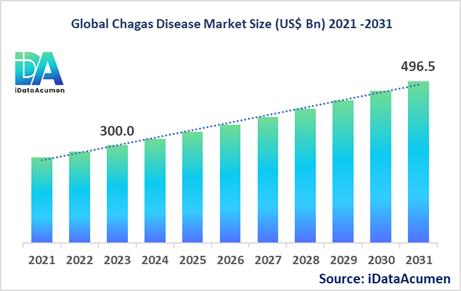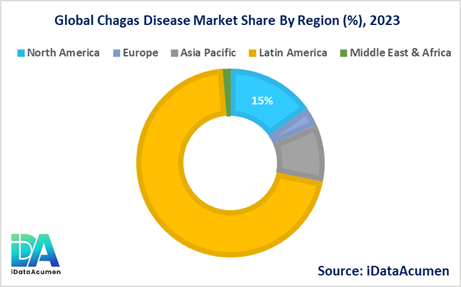Market Analysis:
The Chagas Disease Market size is expected to reach US$ 496.5 million by 2031, from US$ 300 million in 2023, at a CAGR of 6.5% during the forecast period. Chagas disease, also known as American trypanosomiasis, is a tropical parasitic disease caused by the protozoan Trypanosoma cruzi. It is spread mainly by insects known as Triatomine bugs. The disease is endemic to Central and South America, where it affects around 6-7 million people. If left untreated, it can be fatal.

Chagas disease is characterized by an acute phase with mild symptoms, followed by a chronic phase which can eventually lead to heart complications and digestive problems years after the initial infection.
Key drivers of the Chagas disease market include the high prevalence of the disease in Latin American countries, growing public-private initiatives for awareness and control programs, increasing research funding, and advancement in diagnostics and treatment options.
The Chagas Disease Market is segmented by treatment type, diagnosis type, end-user and region. By treatment type, the antiparasitic medication segment accounts for the largest market share due to the lack of vaccines and high use of benznidazole and nifurtimox drugs for treatment. Specifically, the use of antiparasitic medication has risen as they can cure Chagas disease if given promptly during the acute phase.
Epidemiological Insights:
- Chagas disease causes around 7,000 deaths annually, and over 6 million people are estimated to be infected worldwide.
- The disease burden is the highest in 21 endemic Latin American countries. Bolivia has the highest prevalence rate at 6.1% of the population.
- Epidemiological trends show increasing prevalence in recent years in countries like Honduras, Argentina, Bolivia and Mexico.
- In non-endemic regions like Europe, US, Canada and Australia, imported cases are rising due to migration. Europe has around 80,000 - 100,000 cases.
- The US has around 300,000 individuals with Trypanosoma cruzi infection. Most cases are imported.
- Overall, the patient pool is growing steadily globally, providing opportunities for treatment and diagnosis. Chagas disease is a neglected tropical disease.
Market Landscape:
- There are high unmet needs for diagnostics and treatment options for Chagas disease, especially in less developed endemic regions. Many patients remain undiagnosed.
- Currently benznidazole and nifurtimox are the only two drugs approved for etiological treatment. Supportive therapy is given for managing symptoms.
- Several new compounds like E1224, posaconazole and fosravuconazole are in pipeline. Vaccine candidates from Merck, Sanofi and Chemo are also under development.
- Point-of-care rapid diagnostic tests have been launched by companies like Abbott, Chembio Diagnostics, allowing early diagnosis.
- The market has a mix of innovator companies like Sanofi, generic manufacturers like Insud Pharma and diagnostic players like Abbott, Bio-Rad Labs.
Market Scope:
|
Key Insights |
Description |
|
The market size in 2023 |
US$ 300 Mn |
|
CAGR (2024 - 2031) |
6.5% |
|
The revenue forecast in 2031 |
US$ 495.5 Mn |
|
Base year for estimation |
2023 |
|
Historical data |
2019-2023 |
|
Forecast period |
2024-2031 |
|
Quantitative units |
Revenue in USD Million, and CAGR from 2021 to 2031 |
|
Market segments |
|
|
Regional scope |
North America, Europe, Asia Pacific, Latin America, Middle East, and Africa |
|
Market Drivers |
|
|
Market Restraints |
|
|
Competitive Landscape |
Sanofi, Bayer, Abbott, Chemo, Merck, Eisai, Celgene, Insud Pharma, Exeltis, Immune Therapeutics |
Market Drivers:
Increasing Disease Prevalence
Chagas disease is highly endemic in 21 Latin American countries with an estimated 6 million people infected. The disease causes around 7,000 deaths annually. Countries like Bolivia, Argentina and Mexico are experiencing an increase in disease prevalence in recent years which is driving the need for better diagnosis and treatment. The rising patient pool globally presents opportunities for market growth.
Advancements in Diagnostics
The development of improved Chagas diagnostics has enabled early and accurate detection of the disease. Conventional microscopy tests are being replaced by more sensitive molecular assays like PCR testing. Rapid diagnostic tests based on immunoassays provide results within 20 minutes from just a finger-prick blood sample. Companies are launching point-of-care tests which allow diagnosis in low resource endemic regions, expanding testing access.
Drug Development Efforts
Only two antiparasitic drugs, benznidazole and nifurtimox are currently approved for Chagas disease treatment. The unmet need for better medications with less side effects and improved efficacy is driving R&D by companies to develop new compounds. Several pipeline assets like E1224, posaconazole, fosravuconazole are in clinical trials. Approvals of pediatric indications for existing drugs also aim to address unmet needs.
Implementation of Screening & Control Measures
Government and NGO initiatives to increase screening for Chagas infections among high-risk populations is aiding early diagnosis. Vector control programs including insecticide spraying and housing improvements to prevent triatomine bug infestations have helped reduce disease transmission rates in endemic areas. Blood bank screening helps safeguard donations. Such programs will propel market growth.
Market Opportunities:
Need for Pediatric & Chronic Treatments
Most Chagas drugs are only approved for adults and acute infection. Developing treatments specifically for children and chronic Chagas disease offers an area of unmet need. Companies are conducting trials to expand approved therapies for pediatric use. New drugs that can treat congenital transmission and address cardiac/digestive manifestations of chronic Chagas are required.
Underpenetrated Non-Endemic Markets
In non-endemic regions like North America, Europe, Asia Pacific the market remains underpenetrated due to limited awareness and paucity of treatment options. As imported cases rise owing to globalization, launching awareness programs and localized testing/treatment approaches tailored to these markets offers room for growth.
Vaccine Development
No vaccines for Chagas disease exist yet. Development of vaccines that can provide long-term protective immunity against Trypanosoma cruzi can be a game-changer in reducing incidence, especially in endemic regions. Several candidates like Tc24, TSA-1 are under research, which can tap the vaccine demand.
tie-ups with NGOs
Partnerships with non-profits and NGOs operating in underdeveloped endemic areas can improve access and affordability. NGOs can conduct education/awareness campaigns. Market players can work with them for diagnosis/treatment camps. Such partnerships can aid growth in underserved markets.
Market Trends:
Digital Health Integration
Digital tools like telemedicine and health apps are enhancing Chagas disease management. Doctors can monitor and advise patients remotely. Apps can help patients track symptoms and medication intake. Digital pathology is enabling remote diagnosis. Machine learning can improve screening algorithms. Such technologies are making care more accessible.
Point-of-Care Testing Adoption
Point-of-care rapid diagnostic tests are seeing rising adoption as they allow quick diagnosis in resource-limited endemic areas without requiring advanced lab infrastructure. The convenience and fast turnaround time of such tests is facilitating prompt case identification and treatment initiation.
Growing Research Funding & Collaborations
Increasing research funding from both public and private entities is contributing towards Chagas disease R&D. Collaborations between pharma firms, academics institutions and NGOs are also growing, enabling pooling of resources and expertise to accelerate drug and vaccine development.
Rise of Contract Research Organizations
The use of contract research organizations (CROs) for clinical testing services and manufacturing is rising as companies look to optimize costs and productivity. CROs provide flexibility to scale research activities. Several CROs offer end-to-end preclinical to clinical capabilities for tropical diseases like Chagas.
Market Restraints:
Low Awareness in Rural Endemic Areas
Lack of awareness in remote endemic regions leads to underdiagnosis and poor surveillance. Indigenous rural populations often have limited access to healthcare and testing facilities. This negatively impacts disease control and treatment adoption, restraining market growth. Active community outreach programs are essential.
High Treatment Costs & Low Disposable Incomes
The annual cost of Chagas treatment using benznidazole/nifurtimox can be nearly $3300 which is unaffordable for economically disadvantaged sections in endemic areas. Low disposable incomes in endemic countries coupled with limited insurance coverage and healthcare access hampers growth prospects.
Stringent Regulatory Approval Processes
The lengthy clinical testing and approvals process poses challenges for companies trying to bring new Chagas drugs or vaccines to market. The small patient population makes recruiting for trials difficult. Requirements differ across endemic/nonendemic countries. Such factors lead to product launch delays.
Recent Developments:
|
Development |
Involved Company |
|
Launch of Lampit point-of-care test for Chagas disease |
Leti Pharma |
|
FDA approval of benznidazole for pediatric Chagas patients |
Chemo Group |
|
Strategic partnership between Vaxiion and University of Georgia for Chagas vaccine |
Vaxiion Therapeutics, University of Georgia |
|
Acquisition of InBios International by Bio-Rad Laboratories |
Bio-Rad Laboratories, InBios |
|
Product Launch |
Company Name |
|
In Sept 2022, Leti Pharma gained FDA approval for Lampit, a rapid point-of-care immunochromatographic test for detecting Chagas disease. This test uses a finger-prick blood sample and provides results within 20 minutes, facilitating timely diagnosis. |
Leti Pharma |
|
In August 2021, Chemo Group received FDA approval to extend the use of benznidazole for treating Chagas disease in pediatric patients 2 to 12 years of age. Previously it was only approved for ages 12 and above. This expanded access fulfills an unmet need. |
Chemo Group |
|
In May 2020, Abbott received FDA approval for its Alinity m Chagas assay, a serology test for screening blood samples and diagnosing Chagas infection. This next-gen assay provides fast, high-sensitivity results to aid blood screening. |
Abbott |
|
Merger/Acquisition |
Involved Companies |
|
In March 2021, Bio-Rad Laboratories acquired InBios International, a leading developer of diagnostic tests for infectious diseases like Chagas. This expanded Bio-Rad's infectious disease diagnostics portfolio with new FDA-approved assays. |
Bio-Rad Laboratories |
|
In 2019, Roche acquired Chagas disease diagnostic maker TIB Molbiol to expand its PCR-based assay offerings and research capabilities in infectious disease testing. |
Roche |
Market Regional Insights:
Chagas disease is highly endemic in Latin American countries, which comprise the bulk of the global patient pool.
- Latin America was the largest market for Chagas disease treatment in 2024, accounting for over 70% of global revenue share. High disease burden in countries like Brazil, Argentina, Bolivia is driving the market demand.
- North America was the second largest market, accounting for around 15% revenue share in 2024. Most cases are imports from endemic areas in Latin America. Rising screening is fueling the North America market.
- Asia Pacific is expected to exhibit the fastest growth at a CAGR of 9.8% during 2024-2031. Increasing imports, growing awareness and control measures being implemented by governments will boost the APAC market.

Market Segmentation:
- By Treatment Type
- Antiparasitic Medication
- Symptomatic and Supportive Treatment
- Vaccines
- Others (stem cell therapy, gene therapy)
- By Diagnostic Test
- Microscopic Examination
- Molecular Tests (PCR)
- Immunodiagnostics (ELISA)
- Others (imaging, cultures)
- By End-User
- Hospitals
- Diagnostic Laboratories
- Academic and Research Institutes
- Others (blood banks, NGOs)
- By Regions
- North America
- Europe
- Asia Pacific
- Latin America
- Middle East & Africa
Top companies in the Chagas Disease Market:
- Sanofi
- Bayer
- Abbott
- Chemo
- Merck
- Eisai
- Celgene
- Insud Pharma
- Exeltis
- Immune Therapeutics